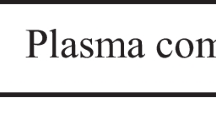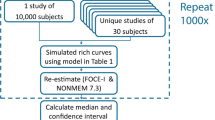Abstract
Background
Fat-free mass (FFM)-based dose scaling is increasingly being adopted in clinical pharmacology. Given the complexities with the measurement of FFM in clinical practice, choosing an appropriate equation for FFM is critical for accurate dose scaling. Janmahasatian’s FFM model (FFMJan) has largely remained the preferred choice because of its mechanistic basis and good predictive properties. This model was, however, developed from a largely European cohort and has been shown to give biased predictions of FFM in Indian people.
Objective
The objective of this work was to derive an extended version of the FFMJan model (FFMExt) that accounts for the variation in body composition due to ethnicity, and to demonstrate its application by developing an extended FFM model in an Indian population (FFMExt,Ind).
Methods
The fundamental assumption of FFMJan model development was a linear relationship between bioimpedance and body mass index. In this extension to Janmahasatian’s work, this assumption was extended to allow for potential non-linear relationships. While the original ZJan model parameters were kept fixed, a set of body composition-related parameters \(\varPsi \{ \psi_{1} , \;\psi_{2} , \;\psi_{3} \}\) were incorporated, where \(\psi_{1}\) and \(\psi_{2}\) were the ethnicity factors to the intercept and the linear coefficient, respectively, and \(\psi_{3}\) a non-linear exponent. The model was then applied to data arising from a south Indian population and the \(\varPsi\) parameters were estimated by standard non-linear regression. The data were generated from a reference model for FFM for the Indian population, which was known to provide unbiased estimates for this population.
Results
The parameter estimates (%RSE) of the final FFMExt,Ind model were \(\psi_{1} = 0\) (fixed), \(\psi_{2} = 0.77\) (3.2%) for male patients, 0.70 (3.3%) for female patients, and \(\psi_{3} = 0.72\) (12.4%). The final model predictions were in good agreement with the reference model predictions.
Conclusions
An FFMExt model has been achieved by extending the original FFMJan model assumptions to account for inter-ethnic differences in body composition. The extended model can be applied to any ethnic population by estimating a set of body composition-related parameters \(\varPsi\). This can be performed using bioimpedance data without the need for formal FFM measurements.





Similar content being viewed by others
References
Siri WE. Body composition from fluid spaces and density: analysis of methods. In: Josef Brozek AH, editor. Techniques for measuring body composition. Washington, DC: National Academy of Sciences-National Research Council; 1961. p. 223–44.
Sinha J, Duffull SB, Al-Sallami HS. A review of the methods and associated mathematical models used in the measurement of fat-free mass. Clin Pharmacokinet. 2018;57(7):781–95.
Green B, Duffull SB. What is the best size descriptor to use for pharmacokinetic studies in the obese? Br J Clin Pharmacol. 2004;58(2):119–33.
De Baerdemaeker LE, Mortier EP, Struys MM. Pharmacokinetics in obese patients. Contin Educ Anaesth Crit Care Pain. 2004;4(5):152–5.
Han P, Duffull S, Kirkpatrick C, Green B. Dosing in obesity: a simple solution to a big problem. Clin Pharmacol Ther. 2007;82(5):505–8.
Eleveld DJ, Proost JH, Absalom AR, Struys MM. Obesity and allometric scaling of pharmacokinetics. Clin Pharmacokinet. 2011;50(11):751–3.
Leykin Y, Miotto L, Pellis T. Pharmacokinetic considerations in the obese. Best Pract Res Clin Anaesthesiol. 2011;25(1):27–36.
De Baerdemaeker LEC, Van Limmen JGM, Van Nieuwenhove Y. How should obesity be measured and how should anesthetic drug dosage be calculated? In: Leykin Y, Brodsky JB, editors. Controversies in the anesthetic management of the obese surgical patient. Milan: Springer; 2013. p. 15–30.
Ingrande J, Brodsky JB, Lemmens HJ. Lean body weight scalar for the anesthetic induction dose of propofol in morbidly obese subjects. Anesth Analg. 2011;113(1):57–62.
Cortinez LI, Anderson BJ, Holford NH, Puga V, de la Fuente N, Auad H, et al. Dexmedetomidine pharmacokinetics in the obese. Eur J Clin Pharmacol. 2015;71(12):1501–8.
La Colla L, Albertin A, La Colla G, Porta A, Aldegheri G, Di Candia D, et al. Predictive performance of the ‘Minto’remifentanil pharmacokinetic parameter set in morbidly obese patients ensuing from a new method for calculating lean body mass. Clin Pharmacokinet. 2010;49(2):131–9.
Janmahasatian S, Duffull SB, Ash S, Ward LC, Byrne NM, Green B. Quantification of lean bodyweight. Clin Pharmacokinet. 2005;44(10):1051–65.
Al-Sallami HS, Goulding A, Grant A, Taylor R, Holford N, Duffull SB. Prediction of fat-free mass in children. Clin Pharmacokinet. 2015;54(11):1169–78.
Rush EC, Plank LD, Laulu MS, Robinson SM. Prediction of percentage body fat from anthropometric measurements: comparison of New Zealand European and Polynesian young women. Am J Clin Nutr. 1997;66(1):2–7.
Rush E, Plank L, Chandu V, Laulu M, Simmons D, Swinburn B, et al. Body size, body composition, and fat distribution: a comparison of young New Zealand men of European, Pacific Island, and Asian Indian ethnicities. N Z Med J. 2004;117(1207):U1203.
Rush EC, Freitas I, Plank LD. Body size, body composition and fat distribution: comparative analysis of European, Maori, Pacific Island and Asian Indian adults. Br J Nutr. 2009;102(4):632–41.
Swinburn B, Ley S, Carmichael H, Plank L. Body size and composition in Polynesians. Int J Obes. 1999;23(11):1178.
Deurenberg P, Deurenberg-Yap M, Guricci S. Asians are different from Caucasians and from each other in their body mass index/body fat per cent relationship. Obes Rev. 2002;3(3):141–6.
Srigiripura CV, Urooj A, Krishnarao CS, Anand MP. Validation of fat-free mass estimation using prediction equations in male patients with chronic obstructive pulmonary disease. Int J Nutr Pharmacol Neurol Dis. 2017;7(4):94–100.
Kulkarni B, Kuper H, Taylor A, Wells JC, Radhakrishna KV, Kinra S, et al. Development and validation of anthropometric prediction equations for estimation of lean body mass and appendicular lean soft tissue in Indian men and women. J Appl Physiol. 2013;115(8):1156–62.
McLeay S, Morrish G, Ponnuswamy T, Devanand B, Ramanathan M, Venkatakrishnan L, et al. Noninvasive quantification of hepatic steatosis: relationship between obesity status and liver fat content. Open Obes J. 2014;6(1):16–24.
Akaike H. A new look at the statistical model identification. IEEE Trans Autom Control. 1974;19(6):716–23.
Acknowledgements
The authors acknowledge the contribution of T. K. Ponnuswamy, B. Devanand, M. Ramanathan, S. Ramalingam and Bruce Green for collecting and sharing the demographic data of 100 adult Indian patients for this analysis. During the conduct of the study, T. K. Ponnuswamy, B. Devanand and S. Ramalingam were from the PSG Institute of Medical Sciences and Research, Coimbatore, India; M. Ramanathan was from the PSG College of Pharmacy, Coimbatore, India and Bruce Green was from Model Answers R&D Pty Ltd, Brisbane, QLD, Australia.
Author information
Authors and Affiliations
Corresponding author
Ethics declarations
Funding
This work required no specific funding. Jaydeep Sinha received a doctoral scholarship from the School of Pharmacy, University of Otago, New Zealand during this work.
Conflict of interest
Jaydeep Sinha, Hesham S. Al-Sallami and Stephen B. Duffull have no conflicts of interest that are directly relevant to the content of this article.
Ethics approval
No ethical approval was required for this analysis.
Electronic supplementary material
Below is the link to the electronic supplementary material.
Rights and permissions
About this article
Cite this article
Sinha, J., Al-Sallami, H.S. & Duffull, S.B. An Extension of Janmahasatian’s Fat-Free Mass Model for Universal Application Across Populations of Different Ethnicities. Clin Pharmacokinet 59, 1161–1170 (2020). https://doi.org/10.1007/s40262-020-00883-1
Published:
Issue Date:
DOI: https://doi.org/10.1007/s40262-020-00883-1




